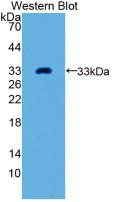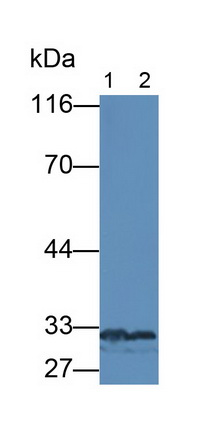Monoclonal Antibody to Growth Differentiation Factor 11 (GDF11) 

BMP11; Bone morphogenetic protein 11
Overview
Properties
- Product No.MAC113Hu21
- Organism SpeciesHomo sapiens (Human) Same name, Different species.
- ApplicationsWB
If the antibody is used in flow cytometry, please check FCM antibodies.
Research use only - DownloadInstruction Manual
- CategoryCytokineNeuro scienceOphthalmology & OtorhinolaryngologyDevelopmental scienceBone metabolism
- SourceMonoclonal antibody preparation, Host Mouse
- Ig Isotype IgG2b Kappa, Clone Number C4
- PurificationProtein A + Protein G affinity chromatography
- LabelNone
- Immunogen RPC113Hu01-Recombinant Growth Differentiation Factor 11 (GDF11)
- Buffer Formulation0.01M PBS, pH7.4, containing 0.05% Proclin-300, 50% glycerol.
- TraitsLiquid, Concentration 1mg/mL
Sign into your account
Share a new citation as an author
Upload your experimental result
Review

Contact us
Please fill in the blank.
Specifity
The antibody is a mouse monoclonal antibody raised against GDF11. It has been selected for its ability to recognize GDF11 in immunohistochemical staining and western blotting.
Usage
Western blotting: 0.5-2µg/mL;
Immunohistochemistry: 5-20µg/mL;
Immunocytochemistry: 5-20µg/mL;
Optimal working dilutions must be determined by end user.
Storage
Store at 4°C for frequent use. Stored at -20°C in a manual defrost freezer for two year without detectable loss of activity. Avoid repeated freeze-thaw cycles.
Stability
The thermal stability is described by the loss rate. The loss rate was determined by accelerated thermal degradation test, that is, incubate the protein at 37°C for 48h, and no obvious degradation and precipitation were observed. The loss rate is less than 5% within the expiration date under appropriate storage condition.
Organism Species More: Rattus norvegicus (Rat)Giveaways
Increment services
-
 Antibody Labeling Customized Service
Antibody Labeling Customized Service
-
 Protein A/G Purification Column
Protein A/G Purification Column
-
 Staining Solution for Cells and Tissue
Staining Solution for Cells and Tissue
-
 Positive Control for Antibody
Positive Control for Antibody
-
 Tissue/Sections Customized Service
Tissue/Sections Customized Service
-
 Phosphorylated Antibody Customized Service
Phosphorylated Antibody Customized Service
-
 Western Blot (WB) Experiment Service
Western Blot (WB) Experiment Service
-
 Immunohistochemistry (IHC) Experiment Service
Immunohistochemistry (IHC) Experiment Service
-
 Immunocytochemistry (ICC) Experiment Service
Immunocytochemistry (ICC) Experiment Service
-
 Flow Cytometry (FCM) Experiment Service
Flow Cytometry (FCM) Experiment Service
-
 Immunoprecipitation (IP) Experiment Service
Immunoprecipitation (IP) Experiment Service
-
 Immunofluorescence (IF) Experiment Service
Immunofluorescence (IF) Experiment Service
-
 Buffer
Buffer
-
 DAB Chromogen Kit
DAB Chromogen Kit
-
 SABC Kit
SABC Kit
-
 Long-arm Biotin Labeling Kit
Long-arm Biotin Labeling Kit
-
 Real Time PCR Experimental Service
Real Time PCR Experimental Service
Citations
- Splenocytes derived from young WT mice prevent AD progression in APPswe/PSENldE9 transgenic micePubMed: 26317549
- TGFβ Superfamily Members Mediate Androgen Deprivation Therapy-Induced Obese Frailty in Male Micepubmed:27611336
- GDF11 is increased in patients with myelodysplastic syndromefiles:ijcep0024948.pdf
- GDF11 does not improve the palmitate induced insulin resistance in C2C12.pubmed:28485800
- РОЛЬ ДИФФЕРЕНЦИРОВОЧНОГО ФАКТОРА РОСТА 11 (GDF11) В РЕГУЛЯЦИИ ЛИПИДНОГО ОБМЕНА И КАРДИОГЕМОДИНАМИЧЕСКИХ ФУНКЦИЙ …Cyberleninka:Source
- GDF11 is increased in patients with aplastic anemiaPubmed: 30727851
- GDF11 prevents the formation of thoracic aortic dissection in mice: Promotion of contractile transition of aortic SMCs33764670
- The relationship between transforming growth factor β superfamily members (GDF11 and BMP4) and lumbar spine bone mineral density in postmenopausal Chinese …34417839
- Low-Intensity Exercise Routine for a Long Period of Time Prevents Osteosarcopenic Obesity in Sedentary Old Female Rats, by Decreasing Inflammation and …34336096








